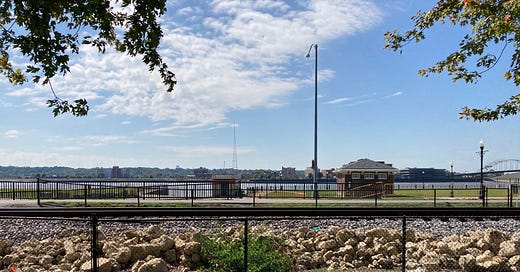Fight or take the money and stand down.
That’s the choice facing a lot of river towns in the path of the Canadian Pacific/Kansas City Southern railroad merger these days.
As locals know, the biggest cities around here – Muscatine, Davenport and Bettendorf – have all signed deals with Canadian Pacific, agreeing not to oppose the merger in exchange for cash. The payments are pending the merger’s approval.
Others are fighting, though.
(For those who don’t know about this story, the proposed $31 billion merger between the two railroads — which still needs federal approval — would triple the amount of train traffic going through our cities and towns. The merged railroad would link Mexico, the U.S. and Canada.
It’s a big deal, and a lot of people aren’t happy.
Officials in Camanche, in Clinton County, say the railroad isn’t offering nearly enough money to compensate for the merger’s impact, and locals packed the City Hall there this week to protest.
In Princeton, the mayor has told me he won’t agree to a deal with the railroad. He’s said the merger will devastate small towns.
It’s a tough choice for some cities, and it’s not one anybody here wanted to have to make.
But this isn’t the first time.
Three years ago, the people of Davenport were stunned one day to see Canadian Pacific significantly raising the railroad tracks that skirt the city’s riverfront.
The city was in the midst of the disastrous 2019 floods, and the railroad raised the tracks to make sure its trains could get through.
Political leaders and riverfront advocates squawked. At least, at first.
But it didn’t take long for the politicians in Davenport to say there was no use fighting. Railroads have broad authority over their operations. So, the city entered into talks and worked with Canadian Pacific to improve the areas affected by the newly raised tracks.
Now, we’re going down that road again.
This time, it’s more than just Davenport. Other cities have come to the conclusion that it's not worth fighting the railroad.
Bettendorf Mayor Bob Gallagher complained vehemently when the merger was announced last year. But he said city officials read past cases before the Surface Transportation Board, the federal body that decides whether to approve the merger and came to this conclusion: “We thought it would be next to impossible to get it stopped,” he said.
Thus, the deals with the railroad. A lot of the money the cities are getting will go toward creating “quiet zones,” where trains won’t be able to routinely blow their horns when approaching an intersection. The money is supposed to make these crossings safer so the federal government will waive the rule requiring the horns in these places. The money will also go toward protecting the regional water pollution control plant.
Some people here wish the big cities hadn’t given up, though. The STB is holding a public hearing on the merger Sept. 13 at the RiverCenter in Davenport, and there is a grassroots movement afoot called Stop the Train to oppose the plan. Its online petition had gathered more than 400 signatures as of Wednesday.
There are other steps opponents are taking to fight back, I’m told. And you can expect town leaders who are opposed will also show up to protest at the hearing.
Further up the tracks, a coalition of Chicago-area suburbs are fighting the merger. Federal officials are sure to get an earful from them. They’re reportedly asking the STB to order the railroads to modify their operating plan.
Will any of this make a difference?
I can't predict the outcome, but I know this: The STB’s draft environmental impact statement said the merger’s effect on freight and passenger rail safety would be minor to negligible. It even said the deal could have a positive environmental impact.
Some critics have panned the study, but this isn’t a good sign for those who want the merger to fail.
It’s true, the study said there would be “unavoidable adverse noise impacts.” But now that some of the largest cities where that impact would be felt have stood down, you can’t help but think it will make the railroads’ case easier. (The Scott County Board of Supervisors said recently it will oppose the merger.)
Maybe these cities made the right choice. Davenport got $10 million; Bettendorf and Muscatine each got $3 million. Cities with quiet zones say they work, and as local leaders say, fighting the merger could have left them with nothing.
But what about our riverfront? Downtown business leaders in Davenport say quiet zones won’t solve the problem of getting access to the levee with so many new trains passing every day.
This is no small thing. The riverfront is where we hold concerts; it’s where our picture-perfect minor league baseball stadium is located; it’s where we have and will continue to pour public money. Davenport is currently working an attraction in this very area using $6 million in public funds.
And what of the smaller towns that didn’t get the same deal as the larger cities? Who can’t afford their own quiet zones. What are they going to do?
These are tough calls. I realize that. These cities that took the deal may well be right that stopping the merger isn’t possible.
Still, I can’t help but think about Davenport’s decision not to fight back three years ago.
As I walk along the riverfront now, it looks better than it did right after the tracks were raised. The intersections where vehicle traffic passes are improved. The railroad won’t have to worry about getting through when there’s flooding, either. I don’t deny that’s a benefit to the overall economy.
But it also is true that, for those of us who live here, our relationship with the riverfront isn’t the same. The view of the river and our ability to get to it are definitely altered. That’s not nothing. And with this merger pending, I also wonder whether private interests will still be willing to put money into a riverfront with this much additional railroad traffic.
City officials say they didn’t ask for this merger, and they definitely didn’t want to have to make the choices that have come along with it.
I believe that. It’s an added complication. But as long as some local political leaders think they’re powerless against the railroads (or until they’re convinced the cost of giving up is too high), they won’t stand in the way; they’ll take the best deal they can.
What that means is, if nothing changes, the next time this kind of thing comes along, the outcome will be the same.
Postscript
This is the first edition of Along the River. I call it a place to find news, commentary and ideas from the Quad-Cities, where the river runs east to west.
This publication is intended for the people of the Quad-Cities, where I’ve written about politics, government and trends for 32 years. But it’s also for people who aren’t from the Quads.
I hope by reading, these folks will learn a little bit about this area and its people.
I think we’re worth knowing.
For one thing, our politics are different than in other parts of Iowa. We’re neither full-on red nor blue. We’re purple. In political parlance, we’re a sort of swing district.
At a time when our country is increasingly divided, that’s unusual.
I plan to write more about that later, along with stories about other issues and challenges facing the Quad-Cities and the state of Iowa.
I hope you’ll find this newsletter informative and that it will be worth supporting.
Along the Mississippi is a part of the Iowa Writers’ Collaborative, a collection of journalists and writers from across the state who are worth reading.
Please check them out, and I will see you soon.






Your postscript is a poetic mission statement. I am rooting for and subscribing to you.
This is fascinating, Ed! I’m so looking forward to your columns!